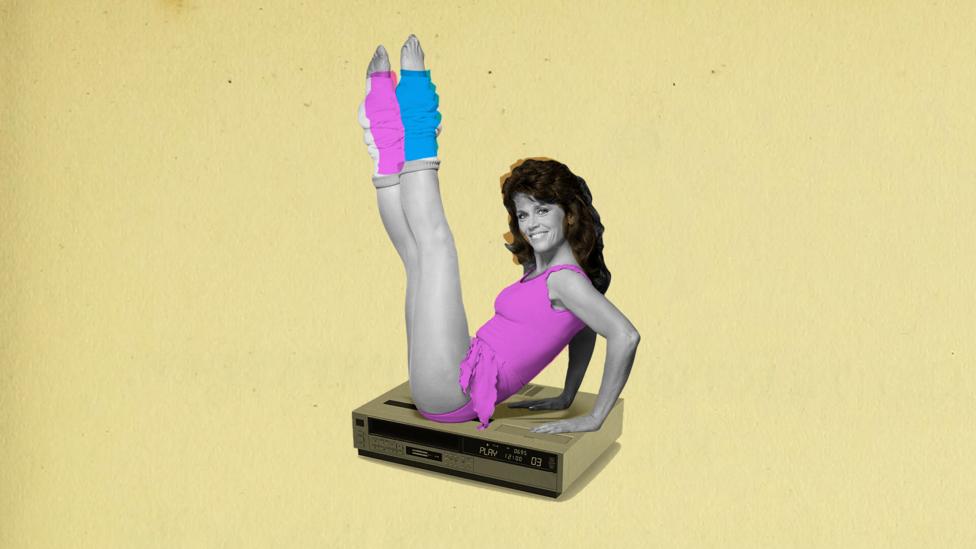Covid-19 has forced us to exercise indoors. But home fitness has been shaping our lives for decades.
Most people remember their first encounter with home fitness. As a kid in the early ‘90s, I remember waking up extra early at the weekends to watch a TV programme called ‘Mousercise’, a Disney show with aerobics instructors in full Mickey and Minnie costumes teaching kids calisthenics. I was far too lazy to participate, but was fascinated by the spectacle nonetheless.
For those born slightly earlier, home fitness might be defined by memories of Jane Fonda grapevining across their TV screen in legwarmers, while for others it might be taking their inaugural steps on that weird-looking contraption known as a treadmill.
Home fitness has been in our lives for decades – and it’s taken on a new role since the Covid-19 pandemic closed gyms around the world. Whether it’s a yoga class on Zoom or panic-buying a Peloton, many of us are trying to find ways to exercise effectively within four walls. But where did the industry of Thighmaster and Wii Fit come from – and where’s it heading after the pandemic?
At first, mostly geared toward women
Exercising has been around for a long time; yoga in India, tai chi in China and Olympic training in Greece go back thousands of years, for example. But ‘fitness’ as we know it today is a relatively new construct, not even 200 years old. One of the earliest examples comes from an illustrated guidebook written in 1861 in Victorian England, which shows women in petticoats and men in neckties exercising different muscle groups. The idea for the daily regimen came from Gustav Ernst, an orthopaedic machinist in London who invented the portable home gym, a device made of mahogany boards, cords, weights and pulleys.

In those pre-transport days, people had more exercise built organically into their day. Gyms were rare; those that existed were almost exclusively frequented by men and “weren’t places where you’d be proud to be seen”, says Natalia Mehlman Petrzela, an associate professor of history at The New School in New York City who’s writing a book about the fitness industry. “They were seen as kind of seedy places where lowlifes would hang out.” And while people (mostly men) played sports, getting sweaty on purpose for health or appearance just wasn’t something most people did.
Home fitness as we know it in the West started to appear sometime after World War Two, with the US behind many of the trends that subsequently swept the globe. Many Americans had bigger homes after the war, plus a huge technological innovation: the television. The economy was booming, young married couples moved to suburbs, people were driving more and public health concerns about obesity started to emerge.
Trends towards open-plan living and technological developments fueled appetite for staying healthy, conveniently, at home – James Stark
“Trends towards open-plan living and technological developments… fueled appetite for staying healthy, conveniently, at home,” says James Stark, associate professor of medical humanities at the University of Leeds in England. Traditionally, men went off to work each day while women stayed at home to do housework. These women became the main target for the nascent home fitness industry, with fitness promoted to them as a key element of their beauty routine.
“A lot of television shows at this time wanted to help women do the tasks required of them,” says Katie Rose Hejtmanek, an associate professor of anthropology at Brooklyn College in New York who specialises in fitness and sport studies. And part of that was the idea that “women needed to maintain their slender physiques” for their husbands.
In 1951, fitness guru Jack LaLanne began broadcasting an exercise TV show largely geared towards housewives: a one-man programme in which he demonstrated exercises like side bends and leg lifts or hangover-curing aerobics set to carnival-like organ music. Targeting this white, middle-class, female audience marked a turning point. Before long, home catalogues and TV adverts followed the cash by offering products and more shows for these beauty-oriented consumers with both time and money.
“With the women exercising at home for Jack LaLanne, it was just a beauty standard: ‘OK, I gotta get this over with, check the box, and then I can go have my martini and my cigarette’,” says Hejtmanek.

TV, gadgets and the gym
Products promising quick fitness fixes and effortless ways to shed pounds have long been a part of the health industry, and in these early days in the 1950s and ‘60s they were heavily aimed at this same demographic.
There were so-called “slim suits” and “sauna suits”: imagine a vinyl full-body jumpsuit that purportedly made you sweat even more while exercising, supposedly making you lose weight faster as you did toe touches in your living room. (They still exist to this day.) And there were, of course, the vibrating belts you’d strap around your thighs or bottom to jiggle the fat away. Even the classic hula hoop was originally sold as exercise equipment; over 100 million were sold in the first six months after the product’s release in 1958.
There’s a “broad social embrace of fitness as something we should be doing, even in our downtime, even when we’re at home and theoretically supposed to be relaxing” – Natalia Mehlman Petrzela
Over the next two decades, personal fitness began moving outside the home and took on a more strenuous tone with the advent of jogging culture. “Exercise and fitness became a lifestyle,” Hejtmanek says, and one that came with a new wardrobe – think leggings, headbands, tank tops and leg warmers. Gyms began opening; bright destinations offering mirrors and group classes, often connected to the offices of big corporations to lure in yuppies.
Then the world of fitness was reshaped by another key technological innovation: the VHS video tape. American actress Jane Fonda stormed onto the scene in 1982 with her Jane Fonda’s Workout video tape which, again, targeted women at home. Over the decade, that tape sold 17 million copies around the world and triggered several follow-up series. Along with the growing popularity of fitness clubs, Petrzela says that the fitness industry was “booming on all fronts”.

“VHS technology is a very big deal because it allows people to have these exercises on what we would now think of as on-demand. It also makes exercise more of an international phenomenon because these VHS tapes can be sent all over the world, which makes the US, in a lot of ways, a kind of headquarters of fitness culture,” she says.
An avalanche of tapes and TV workout programmes followed Fonda’s success, launching careers for fitness personalities like Richard Simmons in the US or Mr Motivator in the UK (who is enjoying a resurgence in the coronavirus era). Other celebrities also followed Fonda’s lead; Australian model Elle MacPherson released “The Body” workout video, while US actress Suzanne Somers came up with the Thighmaster, designed to beef up leg muscles on the sofa while watching TV. Working out at home was now “connected to Hollywood culture”, which strengthened its appeal, Petrzela says.
Next came the home gym. These expensive machines – like Nordic Track’s in-home treadmills, ellipticals or stationary bikes – filled home basements across the world in the 1990s. There were still goofy products – think the Shake Weight, or electric “ab stimulators” you affix to your bare tummy that are supposed to vibrate your gut into a six pack. But deluxe 10-in-one exercise machines, like the ones you’d see at a gym, let people take home fitness more seriously. And all these products served to promote the idea that we should be maximising time and self-improvement.
Nowadays, the fitness and wellness industry “is now a burden in all of our realms” – Katie Rose Hejtmanek
“They speak to, I think, both a broad social embrace of fitness as something we should be doing, even in our downtime, even when we’re at home and theoretically supposed to be relaxing,” says Petrzela. “And they also prey on these insecurities: that if we’re not constantly working to be more healthy and to be more attractive and spending money on those pursuits, that there’s something wrong with us.”

The internet and age of Covid-19
Which brings us to today. Spandex-clad actors in VHS tapes have been replaced with fitness influencers on social media platforms like Instagram, many of whom endorse the same kind of “lose weight fast” dietary supplements or exercise gadgets that the fitness industry always has.
Except now, we largely call it the “wellness industry”. Working out isn’t just about staying in shape; the lines between fitness and the self-help movement have become blurred. “We need exercise not just as a beauty regimen now, and not just as a heart and health situation, now we need to do it for our mental health. This is now a burden in all of our realms,” says Hejtmanek.
And offerings have become even more complex, with “cult-like” group exercise phenomena like SoulCycle, “mindfulness” classes that mix yoga, aromatherapy and soundscapes, and luxury gyms like Equinox offering additional services like childcare and workspaces.
But that was pre-Covid. Now, with gyms closed and outings comprehensively curtailed, we’re all innovating; fitness instructors have been quick to move online, yoga classes have taken to Zoom, and sales of exercise equipment and downloads of fitness apps are all on the rise. Between January and March in the US, for example, sales of fitness equipment shot up 55% as lockdowns began to be activated. Some gyms are even introducing “foster” programmes for their equipment during the pandemic – lending out machines to members for a fee.
Stark, the University of Leeds professor, thinks it’s too early to tell whether coronavirus could lead to a new home workout boom. He thinks the new online classes tap into something that didn’t exist in home fitness before, but believes that the lure of the gym may prove stronger in the long term.
“Gyms fulfil quite a different social role. They are places where exercises done by individuals can be communal and competitive,” he says. “When the lockdown is phased out and then ends, it is much more likely that people will flock back to gyms and sports fields to recapture the vital social, human contact which is also integral to exercise for so many.”
Credit: Source link